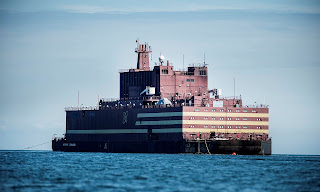Floating nuclear power stations are vessels designed by Rosatom. They are self-contained, low-capacity, floating nuclear power plants. The stations are to be mass-produced at shipbuilding facilities and then towed to the destination ports of the cities and towns experiencing deficit of power due to industrialization.
 The work on such projects dates back to MH-1A in the United States, which was built in the 1960s into the hull of a World War II Liberty Ship; however, the Rosatom project is the first floating nuclear power plant intended for mass production. The initial plan was to manufacture at least seven of the vessels by 2015. On 14 September 2019, Russia’s first-floating nuclear power plant, Akademik Lomonosov, arrived to its permanent location in the Chukotka region. It started operation on 19 December 2019.
The work on such projects dates back to MH-1A in the United States, which was built in the 1960s into the hull of a World War II Liberty Ship; however, the Rosatom project is the first floating nuclear power plant intended for mass production. The initial plan was to manufacture at least seven of the vessels by 2015. On 14 September 2019, Russia’s first-floating nuclear power plant, Akademik Lomonosov, arrived to its permanent location in the Chukotka region. It started operation on 19 December 2019.
In 2000 the project for a floating power station began when the Ministry for Atomic Energy of the Russian Federation (Rosatom) chose Severodvinsk in Arkhangelsk Oblast as the construction site, Sevmash was appointed as general contractor. Construction of the first power station, the Akademik Lomonosov, started on 15 April 2007 at the Sevmash Submarine-Building Plant in Severodvinsk. However, in August 2008 construction works were transferred to the Baltic Shipyard in Saint Petersburg, which is also responsible for the construction of future vessels. Akademik Lomonosov was launched on 1 July 2010, at a cost of 6 billion rubles (232 m$). In 2015 construction of a second vessel starting in 2019 was announced by Russia's state nuclear corporation Rosatom.
The floating nuclear power station is a non-self propelled vessel. It has length of 144.4 metres (474 ft), width of 30 metres (98 ft), height of 10 metres (33 ft), and draught of 5.6 metres (18 ft). The vessel has a displacement of 21,500 tonnes and a crew of 69 people.
Each vessel of this type has two modified KLT-40 naval propulsion reactors together providing up to 70 MW of electricity or 300 MW of heat, or cogeneration of electricity and heat for district heating, enough for a city with a population of 200,000 people. It could also be modified as a desalination plant producing 240,000 cubic meters of fresh water a day. Smaller modification of the plant will be fitted with two ABV-6M reactors with the electrical power around 18 MWe (megawatts of electricity).
The much larger VBER-300 917 MW thermal or 325 MWe and the slightly larger RITM-200 55 MWe reactors have both been considered as a potential energy source for these floating nuclear power stations. More details
 The work on such projects dates back to MH-1A in the United States, which was built in the 1960s into the hull of a World War II Liberty Ship; however, the Rosatom project is the first floating nuclear power plant intended for mass production. The initial plan was to manufacture at least seven of the vessels by 2015. On 14 September 2019, Russia’s first-floating nuclear power plant, Akademik Lomonosov, arrived to its permanent location in the Chukotka region. It started operation on 19 December 2019.
The work on such projects dates back to MH-1A in the United States, which was built in the 1960s into the hull of a World War II Liberty Ship; however, the Rosatom project is the first floating nuclear power plant intended for mass production. The initial plan was to manufacture at least seven of the vessels by 2015. On 14 September 2019, Russia’s first-floating nuclear power plant, Akademik Lomonosov, arrived to its permanent location in the Chukotka region. It started operation on 19 December 2019.In 2000 the project for a floating power station began when the Ministry for Atomic Energy of the Russian Federation (Rosatom) chose Severodvinsk in Arkhangelsk Oblast as the construction site, Sevmash was appointed as general contractor. Construction of the first power station, the Akademik Lomonosov, started on 15 April 2007 at the Sevmash Submarine-Building Plant in Severodvinsk. However, in August 2008 construction works were transferred to the Baltic Shipyard in Saint Petersburg, which is also responsible for the construction of future vessels. Akademik Lomonosov was launched on 1 July 2010, at a cost of 6 billion rubles (232 m$). In 2015 construction of a second vessel starting in 2019 was announced by Russia's state nuclear corporation Rosatom.
The floating nuclear power station is a non-self propelled vessel. It has length of 144.4 metres (474 ft), width of 30 metres (98 ft), height of 10 metres (33 ft), and draught of 5.6 metres (18 ft). The vessel has a displacement of 21,500 tonnes and a crew of 69 people.
The much larger VBER-300 917 MW thermal or 325 MWe and the slightly larger RITM-200 55 MWe reactors have both been considered as a potential energy source for these floating nuclear power stations. More details